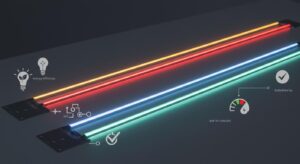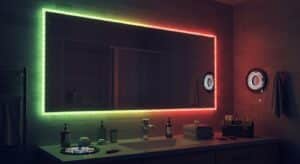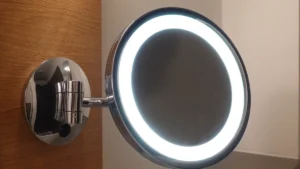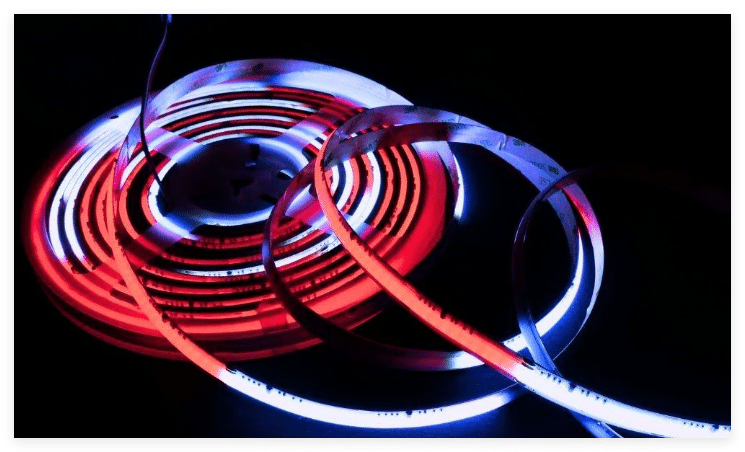
High Density Addressable LEDStrips feature tightly packed lights and intelligent circuits, allowing for individual control of each light. This innovative technology has transformed our approach to lighting design, offering greater options and enhanced accuracy. By 2025, these strips will become even more significant. Advances in energy efficiency, brightness, and smart functionalities are propelling their expansion. High Density Addressable LEDStrips are now utilised for a variety of applications, including architectural lighting and artistic displays. The demand for them is increasing, and the market is expanding rapidly. It is anticipated to grow from £1,280.2 million in 2024 to £2,976.7 million by 2030, indicating a yearly growth rate of 15.1%.
These strips are cost-effective and practical, revolutionising lighting in both homes and businesses.
Key Takeaways
High-density LED strips let you control each light separately.
They use less energy but still give bright, colourful light.
Check how many LEDs are in a metre before buying.
More LEDs make the light look smoother and more even.
Clean and check connections often to keep them working longer.
Use controllers and software to create cool lighting effects.
What Are High-Density Addressable LED Strips?

Definition and Overview
High-density addressable LED strips are modern lights with tightly packed LED beads and smart circuits. These strips let you control each LED separately. Unlike older LED strips, they can create cool effects like colour changes, animations, and gradients. “High density” means many LEDs in one metre, sometimes up to 120 LEDs per metre. This makes the light smooth and even, with no gaps or bright spots.
These strips have special features that make them stand out. Each LED works on its own, thanks to built-in controllers like the WS2811 chip. This chip helps mix colours and adjust brightness accurately. A simple one-wire system connects the strip to controllers, making setup and programming easier. These features make high-density addressable LED strips energy-saving, flexible, and useful for many projects, from home decor to professional displays.
Feature | Description |
|---|---|
Individual Control | Each LED can be adjusted separately for unique lighting effects. |
Integrated PWM Controller | The WS2811 chip helps control brightness and mix colours perfectly. |
One-Wire Data Protocol | A single wire makes it easy to connect and control the strip. |
Versatility in Applications | Great for decorations, stage lighting, and creative projects in different places. |
Energy Efficiency | Using fewer resources while keeping the lights bright and effective. |
Unique Characteristics of High-Density LED Strips
High-density LED strips shine evenly without bright spots or gaps. This is important for places needing smooth lighting, like shops or buildings. Strips with 120 LEDs per metre give the best results for professional setups.
Another special feature is addressability. Each LED can show its own colour or brightness, letting you design detailed patterns. This is done with RGBIC technology, which combines red, green, blue, and control chips in each LED. This makes the strips highly customisable for creative ideas.
These strips also save energy. Controlling each LED separately uses less power but keeps the lights bright. This makes them popular for eco-friendly projects. For example, Barcelona saved 37% on energy costs by using these strips in city lighting.
They are useful in many industries. Shops use them for eye-catching displays. Hotels use colour-changing strips to set relaxing moods. Farms grow more crops with these lights, boosting yields by 23%. These examples show how this technology can change different fields.
Tip: Choose a high-density addressable LED strip based on the number of LEDs and the type of circuit. These details affect how well the strip works for your project.
Key Features of High-Density Addressable LED Strips
LED Density and Smooth Lighting
High-density LED strips are special because they pack many LEDs close together. With up to 120 LEDs in one metre, they give smooth, even light. There are no dark gaps or uneven brightness. This makes them great for places needing seamless lighting, like shops or buildings. The tightly packed LEDs create a steady glow, perfect for both useful and decorative lighting.
These strips make spaces look better with their even lighting. Whether it’s a stylish living room or a bright shop display, the consistent light adds a polished touch. The high LED count also helps place light exactly where needed. This reduces extra fixtures and makes setup easier.
Tip: Check the number of LEDs per metre when choosing a strip. More LEDs work best for detailed and professional designs.
Addressability and Creative Control
A standout feature of these strips is addressability. Each LED can be controlled on its own. This lets you create cool effects and patterns. Advanced RGBIC controllers make this possible. They allow effects like colour chasing and animations. These features are popular for creative and professional displays.
Here’s why addressability is useful:
Dynamic Effects: Make animations, gradients, and other eye-catching visuals.
Custom Control: Adjust each LED to design unique light patterns.
High Impact: Create designs that grab attention and look amazing.
With customisable LEDs, you can explore endless creative ideas. Whether for a stage design or home lighting, these strips let you bring your ideas to life.
Brightness and Colour Choices
High-density LED strips offer many brightness and colour options. Brightness is measured in lumens per foot. The right level depends on the job. For example, mood lighting needs 150–350 lumens per foot. Task lighting might need up to 700 lumens per foot. Use this table to pick the right brightness:
Use | Lumen/Foot Needed |
|---|---|
Mood lighting | 150–350 |
Under cabinet lighting | 175–525 |
Close task lighting | 275–450 |
Far task lighting | 350–700 |
Indirect lighting | 375–575 |
Replace fluorescent tubes | 500–950 |
These strips also offer many colours. Colour temperature, in Kelvins, shows how warm or cool the light is. Warm tones (like 2700K) feel cosy. Cool tones (like 6500K) suit workspaces. The Colour Rendering Index (CRI) ensures colours look natural. Higher CRI values mean more vibrant and true colours.
By mixing adjustable brightness with a wide colour range, these strips fit many needs. They work for soft mood lighting or bold, bright displays.
Energy Efficiency and Power Management
Saving energy is very important in today’s lighting. High-density addressable LED strips are made to use less power while staying bright and colourful. They help save energy without losing quality, making them great for homes and businesses.
How Energy Efficiency Works
These LED strips use smart technology to avoid wasting energy. Each LED works on its own, so you can control brightness and colour exactly. This saves power by using only what is needed. Special circuits like PWM controllers manage energy use. They adjust the current to stop overheating and make the strips last longer.
Tip: Look for strips with a high lumen-per-watt ratio. This shows how much light they make for the energy used.
Power Management Features
Addressable LED strips have smart systems to handle power. These systems keep voltage and current steady across the strip. Long strips often lose brightness, but good designs fix this problem. You can add extra power injectors to keep the light even along the strip.
Many strips let you dim the lights. Lowering brightness saves energy when full light isn’t needed. Some strips work with smart home systems. They can change brightness automatically based on time or light levels.
Why Energy Efficiency Matters
Using less energy lowers costs. You pay less for electricity and help the environment. High-density addressable LED strips use less power than older lights, making them eco-friendly. They also don’t get very hot, which saves even more energy.
For example, shops need bright lights for displays. Switching to these LED strips can cut energy bills by 40% while keeping displays bright and attractive.
Note: Clean and check your strips often to keep them energy-efficient.
Picking the Right Power Supply
Choosing the right power supply is important. Add up the total wattage of your strip and pick a power source with 20% extra capacity. This stops overloading and keeps the strip working well. For long strips, use more than one power supply to spread the load.
Power Supply Tips | Description |
|---|---|
Calculate Wattage | Add up the wattage of all LEDs in the strip. |
Include a Buffer | Pick a power supply with extra capacity to avoid overloads. |
Use Multiple Supplies | For long strips, use more supplies to keep brightness even. |
Energy efficiency and power management make high-density addressable LED strips a top choice for modern lighting. Knowing these features helps you set up better, longer-lasting lighting systems.
How Do High-Density Addressable LED Strips Work?
How Integrated Circuits Control LEDs
High-density LED strips use small chips called ICs to work. These chips are built into the strip and act like tiny brains. They read data signals and tell each LED what to do. This lets you change the colour and brightness of every LED. You can create cool patterns and effects with this control.
The strips also have special parts like PWM controllers. These help the lights change colours smoothly and adjust brightness easily. A single wire connects all the chips, making setup simple. Each chip can control up to three RGB LEDs. This allows for detailed designs and customisation.
Feature | What It Does |
|---|---|
PWM Controller | Controls colour and brightness smoothly for each light. |
Single Wire Connection | Makes wiring easy by linking LEDs with one wire. |
Pixel Control | Each chip manages three LEDs for unique designs. |
Different LED strips use different systems to send signals. For example, SPI strips use SPI signals, while DMX512 strips use DMX512 signals. These systems decide how the chips talk to the controller.
Type of LED Strip | How It Works |
|---|---|
SPI LED Strip | Uses SPI signals to change light colour and brightness. |
DMX512 LED Strip | Uses DMX512 signals to adjust light settings. |
Controllers and Software: How They Help
Controllers and software are key to running these LED strips. The controller sends commands to the chips, telling them what to do. Advanced controllers can use apps, voice commands, or central systems to manage the lights. This makes it easy to control even complex setups.
Software adds more features, like pre-made patterns and animations. It can also save energy by dimming lights when no one is around. This helps the LEDs last longer and reduces electricity use.
Feature | What It Does |
|---|---|
Central Control | Manages multiple systems like lighting and security together. |
Voice and App Control | Lets you control lights using your phone or voice. |
Energy Saving | Adjusts lights based on room use to save power. |
Easy Maintenance | Finds problems and helps fix them quickly. |
Modern controllers are easy to set up and often work right out of the box. They can also connect to building systems for smooth operation. These features make high-density LED strips a great choice for homes and businesses.
Applications of High-Density Addressable LED Strips
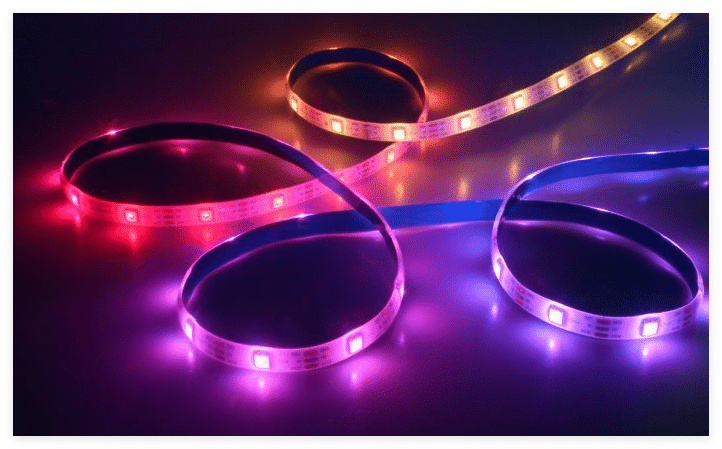
Interior Design and Architectural Lighting
High-density addressable LED strips have changed how we light spaces. They make rooms look better and work better too. These strips are great for creating soft lighting that improves any area. For example, adding LED strips in bathrooms can make them feel calm and relaxing. In living rooms or offices, they mix style with usefulness, lighting up every corner nicely.
When picking LED strips for your home, think about brightness and colour. Warm colours make spaces feel cosy, while cool colours are better for work areas. These strips are flexible and can match any design, from simple homes to bright shops. They also give smooth, even light, making them perfect for lighting up buildings or adding accents to walls.
Advertising, Signage, and Retail Displays
In advertising and shops, these LED strips are very useful. Their bright colours and easy control make them great for signs and displays. Shops use them to show off products and make special areas stand out. For example, RGBIC mode creates colourful patterns that grab attention and bring in more customers.
Buildings also look better with these strips. They can light up details on big towers or small shopfronts. These lights save energy, so businesses can keep displays bright without spending too much. They can also change for holidays like Christmas, making them great for seasonal promotions.
Entertainment, Stage Lighting, and Events
The entertainment world loves these LED strips for their amazing effects. They are used in theatres, clubs, and events to create exciting light shows. These strips last long, save energy, and mix colours well. For example, RGBWW COB LED strips can make smooth colour changes that wow audiences.
They’re not just for big shows. Smaller events like weddings or parties also use them to set the mood. Concerts and festivals rely on these strips for fun and lively atmospheres. They can even sync with music or videos, making them perfect for unforgettable events.
Pro Tip: Use programmable controllers to unlock creative lighting ideas for your events.
DIY Projects and Creative Installations
High-density addressable LED strips are perfect for creative DIY projects. They are flexible, customisable, and produce bright, colourful effects. These features make them great for unique and personal designs.
Why Use High-Density LED Strips for DIY?
These LED strips help you turn ideas into reality. Want a cool gaming setup or a cosy bedroom? These strips can do both. You can create effects like colour fades, animations, or lights that sync with music. Their addressable feature lets you control each LED for detailed designs.
Tip: Pick RGBIC strips for advanced designs. Each LED can show a different colour, giving you more options.
Fun DIY Ideas
Here are some ways to use these LED strips:
Wall Art: Make glowing shapes or patterns on your walls.
Iluminación de muebles: Place strips under furniture for a floating look.
Gaming Setups: Add lights to your PC that match your games.
Holiday Decor: Create bright displays for Christmas or Halloween.
Wearable Lights: Add strips to costumes or accessories for events.
Tools and Tips to Get Started
You’ll need a few things to begin:
Controller: Pick one that works with your project.
Power Supply: Match it to your strip’s voltage and wattage.
Adhesive: Use strong tape or clips to hold the strips in place.
Software: Try apps like WLED to program your lights.
Note: Test everything before installing to avoid mistakes or uneven lighting.
With these tools and ideas, you can make amazing spaces. High-density addressable LED strips let you create lighting that is both useful and beautiful.
Advantages and Disadvantages of High-Density Addressable LED Strips
Benefits of High-Density LED Strips
High-density addressable LED strips have many benefits for modern lighting. They give smooth, even light that makes spaces look better. With up to 120 LEDs per metre, they remove dark spots and uneven brightness. This ensures the light stays consistent across surfaces.
You can control each LED separately, allowing detailed designs and cool effects. These strips can make colour fades, animations, and patterns that match your ideas. They save energy while staying bright, making them great for eco-friendly projects.
These strips are also strong and last a long time. They are made with tough materials that resist damage. Many models have systems to stop overheating, which helps the LEDs last longer. Their small size and flexibility make them easy to fit into tight or curved spaces.
Tip: Choose high-density LED strips for detailed designs like building accents or creative displays.
Limitations and Challenges to Consider
High-density addressable LED strips also have some downsides. Setting them up can be tricky, especially with connectors and dimmable systems. Parts may not work well together, causing problems with signals. Picking the right connectors and controllers is important for smooth operation.
Heat can be an issue. Packed LEDs create more heat, which can lower performance. Without good cooling, the strips may not last as long.
Signal problems can affect lighting effects. Long strips might lose voltage, causing uneven brightness. Adding power injectors or extra supplies can fix this, but it makes setup harder.
Common issues include:
Parts not working well together
Signal problems affecting light patterns
Hard-to-install systems needing careful setup
Heat issues that lower performance
Note: To avoid problems, pick the right parts, follow setup steps, and manage heat properly.
These challenges can seem tough, but good planning can help. By solving these issues, you can use high-density addressable LED strips to their full potential.
Installation and Maintenance Tips for High-Density Addressable LED Strips
Getting Ready for Installation
Prepare well to make your LED strips work better and last longer. First, figure out the power supply you need. Measure the strip length and count the LEDs per metre. Check how much current each LED uses. Look at the datasheet for exact voltage and current details to avoid problems.
Pick the right power supply, then clean the surface where the strips will go. Use a cloth and cleaner to remove dirt. Make sure the surface is dry before sticking the strip down. Press the strip gently to avoid air bubbles.
If the strip is too long, cut it at marked spots. Connect the power supply carefully, matching the voltage and wattage. Add a fuse for safety to stop short circuits.
Tip: Use thick wires and short cables to reduce voltage drop on long strips.
Keeping Your LED Strips in Good Shape
Regular care helps your LED strips stay bright and work well. Dust can build up and make them dim or overheat. Clean them often with a soft, dry cloth to keep them efficient.
Check the electrical connections regularly. Loose or rusty connectors can cause problems. Tighten them and replace broken parts quickly. Look for damage like cracked covers or exposed wires. Fix these to stop further issues.
Watch the temperature of your LED strips. Too much heat can harm the LEDs and shorten their life. If they get too hot, improve airflow or lower the brightness.
Note: For outdoor use, waterproof all connections to protect against rain or moisture.
Solving Common Problems
Fixing issues quickly keeps your LED strips working well. If the strip doesn’t light up, check if the power supply matches the strip’s needs. Use a multimeter to test if the power supply is working.
Dim lights at one end often mean voltage drop. Split the strip into sections or add power injectors to keep brightness even. Loose wires or short circuits can also cause trouble. Check all connections for damage and test them with tools.
Common problems include:
Strip not lighting up
Dim lights at one end
Voltage drop on long strips
Pro Tip: Call an electrician for tricky setups or problems that won’t go away.
High-density addressable LED strips change how we use lights today. They are precise, flexible, and save energy. Each LED can be adjusted for cool effects. This makes them perfect for creative ideas, building designs, or professional setups. Their smooth light and smart controls keep them popular in 2025.
Try them out: Use these LED strips to improve your home, create eye-catching shop displays, or plan exciting events. They are easy to use and full of possibilities. Start using them now to make your lighting stand out!
FAQ
How long do high-density addressable LED strips last?
These LED strips can work for 30,000 to 50,000 hours. Their life depends on how they are used and cared for. Good cooling and a reliable power supply help them last longer.
Can you cut high-density addressable LED strips to fit?
Yes, you can cut these strips at marked spots. Use sharp scissors or a proper cutting tool for neat cuts. Always follow the instructions to avoid damaging the strip.
Are high-density addressable LED strips waterproof?
Some strips are waterproof, but not all of them. Look for IP65 or higher ratings for outdoor or wet areas. Seal all connections to stop water from causing damage.
How do you change the lighting effects on these strips?
You can use a controller and software to adjust the lights. Many controllers work with apps, voice commands, or pre-set options. Advanced ones let you pick colours, animations, and brightness for creative designs.
Do high-density addressable LED strips use a lot of power?
No, these strips save energy while staying bright. They have smart circuits to lower power use. Pick the right power supply to avoid wasting energy or overloading the system.
See Also
Utilising Smart LED Strips for Home Lighting in 2025
Comparative Analysis of High-Brightness LED Strips for All Uses
Best LED Strip Lights of 2024: A Feature and Price Comparison
